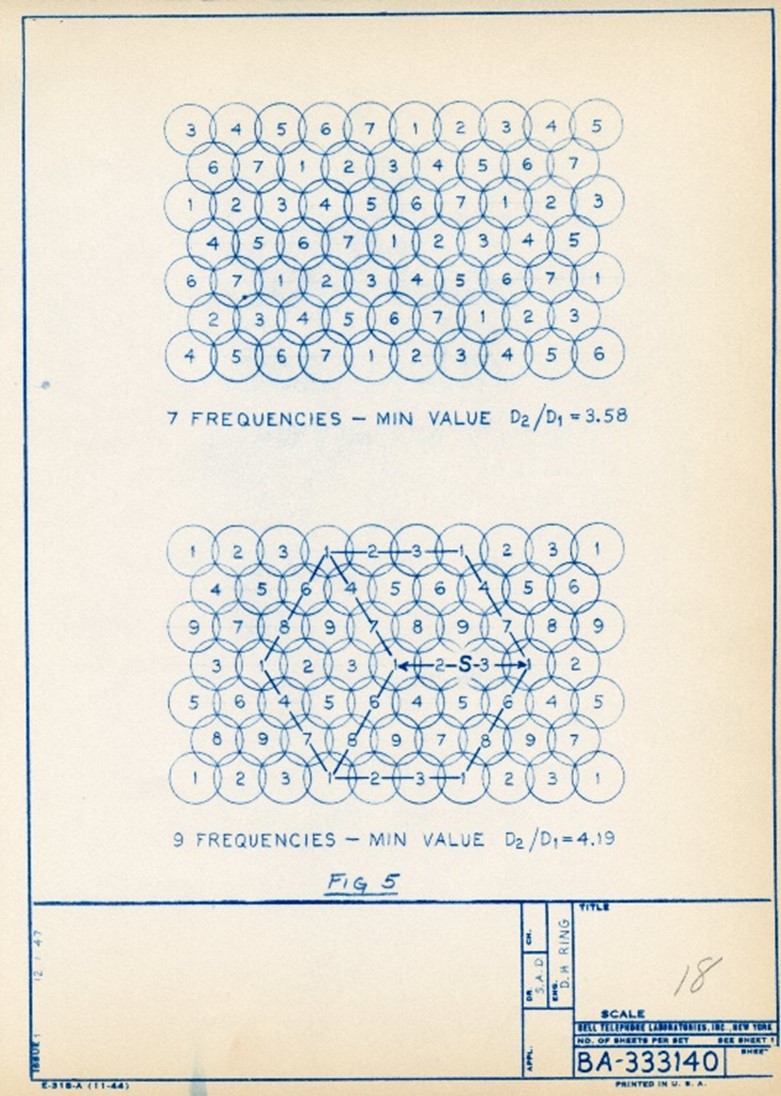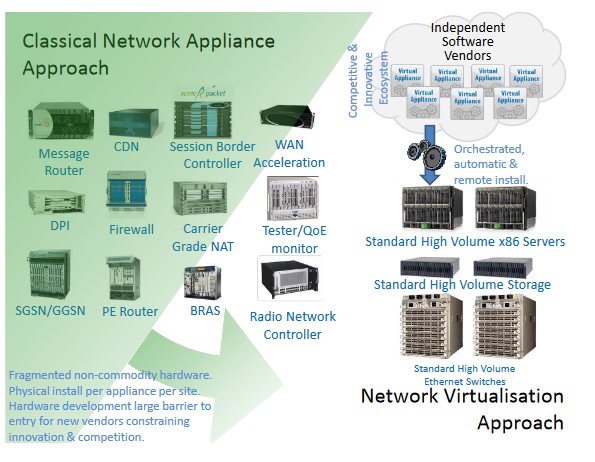Some of the biggest revolutions in connectivity started with people looking at technologies that seemed to be working just fine and asking, “What else is possible?”
By 1876, the telegraph had already made instant dot-dash communication across massive distances a reality for decades. But Alexander Graham Bell had a better idea, and on March 10 of that year he made the first phone call, speaking directly to his assistant. A new world was born.

From 1940 to 1950, the percentage of U.S. homes with telephones jumped from 36.9% to 61.8%. The landline phone had gone mainstream. But Doug Ring, an engineer with AT&T Bell Labs, had an idea for a phone that wasn’t tethered to a house, office, or anywhere else. It would be mobile. In 1947, he drew up the first diagram for a “cellular network”. While it took a few years for the technology to catch up, another new world eventually emerged.

Smartphones were another inflection point. Everything became data. And data wanted to go everywhere. In 2013, we published our blueprint for the network of the future to accommodate the explosive growth in data demand we predicted was coming. In this model, hardware devices like switches, routers and other machines became virtual apps running on servers and it was all controllable online.
That vision of Software Defined Networking was prescient.
Most of our network traffic now rides on this new infrastructure, and our global network now carries more than 614.6 petabytes of data on an average day. From 2018 to the end of 2022, data traffic on our global network increased more than 200%. We expect a 5X increase from 2021 to 2025.

Why the history lesson?
Because our legacy of restless inspiration still drives us. And it’s time for the next big leap.
5G might feel like an incremental, evolutionary advance for our wireless world. But we think it’s a lot more than that. It opens up entirely new capabilities. Coupled with our expanding fiber network and a radical new approach to satellite connectivity, we’re pushing to connect everyone and everything anywhere.
More than that, we’re turning those connections into something smarter, safer, and more accessible that will mean real benefits for consumers, businesses, and software developers. Benefits that simply weren’t possible in previous generations.
In fact, while people keep asking what the killer app will be on this generation of networks, we think the network itself is the killer app. And we’re expanding it, making it more accessible than ever to our customers and developers, and we’ve also created a new product development team to help build future services and experiences for consumers, small and medium-sized businesses and global enterprises and government organizations. Allow me to update you on some progress to date.
EXPANDING THE NETWORK
As we upgrade and expand the nation’s largest wireless and largest fiber network1, we also have to ensure everyone has access to it. Building connectivity out across the country, particularly to traditionally underserved areas, is vital.

That means not just adding more cell towers, but investing in the fiber, as well.
Many people think of fiber as purely a broadband technology for homes and businesses, and certainly that’s a major focus for us. In addition to our standalone efforts, we also recently formed a joint venture called Gigapower with BlackRock which will allow us to provide fiber internet service outside of AT&T’s traditional service areas.
At the same time, our 5G towers and radios are also connected to fiber wherever possible, so that our wireless users have the best possible pathway back to the internet.
Perhaps nowhere is rock solid connectivity more important than our collaboration with the FirstNet Authority to deliver FirstNet to first responders. FirstNet supports 24,000 public-safety agencies as of 1Q2023. Delivering this dedicated Band 14 spectrum has proven immensely valuable in times when first responders need connectivity the most … wildfires, tornadoes, hurricanes and countless other natural disasters. It’s inspiring to watch FirstNet grow over the years and continue to deliver this unique connectivity service to our first responder women and men serving our communities across the United States.
In some of the most rugged and remote areas, building towers and burying fiber just isn’t feasible. But we’re finding solutions there, too. A couple months ago, we participated in the first ever satellite voice call using a standard consumer smartphone with AST SpaceMobile Inc. And last week we participated in repeated successful data downloads of over 10mbps from AST’s BlueWalker 3 satellite. No bulky satellite phone or standalone receiver. Just the same phone many people already have in their pockets. As AST SpaceMobile builds out their satellite fleet, the goal of seamless global connectivity becomes closer to reality, and we couldn’t be prouder to be part of that effort.
EDGE COMPUTING, CYBERSECURITY, AND APIs
“Edge computing” is still nascent, but we’re making it a reality. And you might be one of those readers that says “well, everybody has an edge.” Some truth to this, but I believe AT&T’s edge is different.
Late last year we launched our first “edge zones” in cities across the U.S. This allows carmakers and other businesses to develop cloud-based software that runs on localized networks to minimize latency. And we’re collaborating with cross connect facilities that have fast connections to nearby cloud facilities to put these local 5G edge zones closer to businesses and developers across the country. You don’t have to come to our house to develop … we’re coming closer to you – whether that’s Detroit, Los Angeles, Dallas, Seattle, Washington D.C. or other markets.
In addition to low latency, security is another element that we’re integrating into the network itself. So, it’s not just about putting a firewall inside your four walls and hoping you don’t get burned by hacks, malware, ransomware, phishing schemes and other attacks. We want to put out the forest fire before you even smell the smoke.
We know developers want access to these tools. We’re hard at work finalizing our open API platform that will enable devs to tap into 5G network slicing, or edge computing tools to drive AR and VR devices and applications that require lightweight hardware delivering high-end graphics with near zero lag.
There is an API we’re exploring that would allow applications to set a certain level of quality for the user experience. Another one is threat anomaly detection through which we can notify the user of a threat or take an action based on observed events via APIs. Network Insights API could produce more granular network insights data based on the network performance – for example, determining latency between a device and application.
These are only a few examples. The idea is to accelerate innovation by making it easier for developers and business technologists to get and create advanced connectivity capabilities. We’re excited to see how developers can use our network APIs and capabilities to optimize user experiences and quickly create new, uncharted connectivity products and services.
Turning these types of innovations and ideas into reality and making them accessible to developers is a huge challenge.
NEW PRODUCT DEVELOPMENT TEAM
To that end, about two years ago, we established a new “Product Development” team and overall mindset within AT&T that’s dedicated to these next-gen network capabilities. This new org, headed by senior vice president of product development Andrew Cohen, is a skunkworks focused on turning our future visions into reality and working hand-in-hand with our business, cybersecurity, automotive, mobile connectivity, AT&T Labs, etc. experts.
Staffed by a mix of internal talent and external hires from some of the top web companies, hardware manufacturers, and software developers, our Product Development org is harnessing the groundbreaking technologies being created across our company and across the industry. We’ve been exercising our product invention muscle internally, with select partners, and in collaboration with small, mid-sized and global enterprise customers for several months now. We’ve kept it quiet, but the time for a more public showcase is coming soon. In short, their mandate is to identify current and future customer pain points, move quickly, and take on challenges that, at first glance, might seem insurmountable. But that’s our legacy, and we’re still living it.
CONNECTED CAR
Another great example of what we believe is a key strength of AT&T’s is the automotive industry, and we’re hard at work building cool future products and services. We have tens of millions of connected cars on our network. Those are 4G cars, but 5G cars are right around the corner.
With that upgrade, the expansion of standalone 5G, and the introduction of advanced network services will come the ability to define an auto-grade slice of the network to prioritize safety and mission critical functions of the car, separate from the connectivity used for in-car infotainment.
In addition, 5G enables hyper precise positioning, which will be critical for intelligent transportation systems, teleoperations, autonomous driving and to identify potential roadside obstacles in advance.
To crunch and share that kind of data across the network in near real time we not only need a powerful network. We also need the compute power that do the data crunching to be as geographically close to the vehicles as possible, to offer lower latency and higher service performance. That’s where our edge computing and edge zones I mentioned above come into play.
ARTIFICIAL INTELLIGENCE
Finally, you can’t talk about technology innovation these days without AI.
It might seem like AI instantly exploded from sci-fi daydream to stunning reality just a few months ago with the launch of chatGPT and other AI assistants.

In truth, AT&T has been an AI leader since 1955, when its researchers helped organize the conference where the term “artificial intelligence” was coined. Many of the foundational theories around AI came from Claude Shannon and other Bell Labs researchers who peered into the future and foresaw what would someday be possible. As the technology has caught up with their vision, we’re now seeing AI on the cusp of revolutionizing our lives.
ChatGPT is certainly the element of AI that’s most visible now, and we’re all in with these generative AI tools. We recently launched an internal AI assistant for AT&T employees called Ask AT&T. This assistant is a secure, protected environment where our employees will be able to do things like translating customer and employee documentation from English to other languages to getting help writing code to requesting automated summaries from conference calls. We’re collaborating with Microsoft on this platform and it’s powered by chatGPT. At the same time, we’re maintaining the flexibility to integrate other Large Language Models (or LLMs) into Ask AT&T, as needed. This field is changing and evolving fast, and we’ll be agile and responsive as new technologies become available.
More broadly, as Andy Markus, our chief data officer recently outlined, we’re embedding AI into almost every part of our business. We’re collaborating with companies like Nvidia and Microsoft. And we’re making AI available to all employees as productivity enhancers. By democratizing AI and putting it in the hands of citizen data scientists, we ensure that it benefits everyone.
We’re also focused on what it means to use AI responsibly. We have formal policies and principles in place that guide our approach to AI. And we keep close tabs on the companies and groups at the forefront of creating new AI tools. The government also has a role to play in regulating and monitoring AI. So far, we’re encouraged at the desire to balance innovation and safety.
JOIN THE MOVEMENT
As you can see, building and running a leading-edge network today is vastly more complex than it’s ever been. From edge computing to artificial intelligence and APIs to cybersecurity and satellite connectivity, the demands are greater than ever. We’re actively hiring to continue transforming our network. If you want to be part of something great, to build this new era, to be there at the start of a moment as pivotal as the invention of the telephone and the smartphone, we want you. Come talk to us.
And for those of you at the Collision conference in Toronto this week, you can also find us at our Developer Lounge. In addition to developers finding out more about what our connectivity strengths can do for future apps and services they create, we have a few of our resident experts there to share more on all the topics covered here today. Cybersecurity, artificial intelligence, open API platform, product development and the power of AT&T’s network.
The world is getting more intelligent, more secure, more local and more global. It’s all about the network. Yes, it’s fair to say it’s the killer app. Welcome to the next new world.
PR Archives: Latest, By Company, By Date